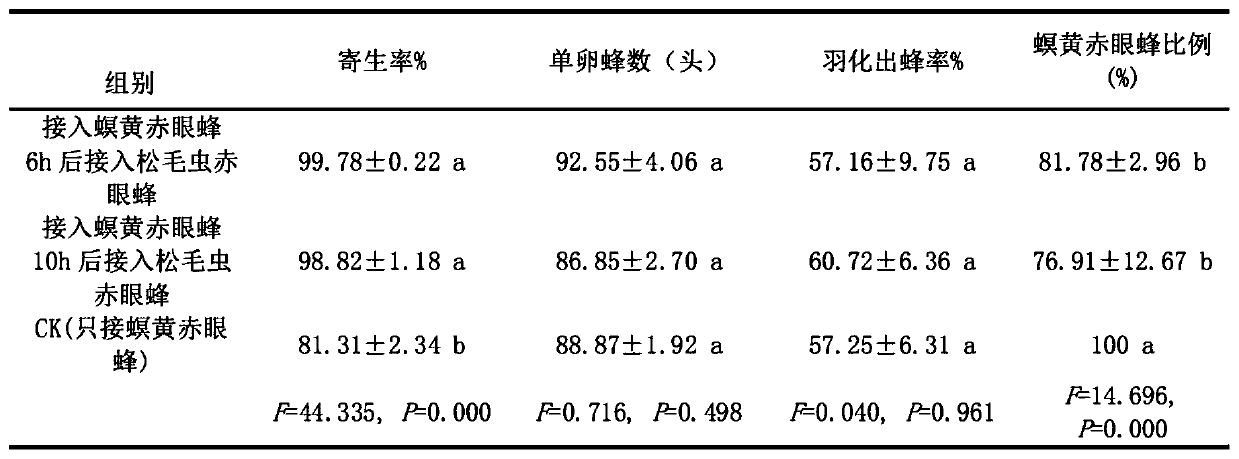Method for increasing utilization rate of antheraea pernyi eggs by trichogramma chilonis
A technology for Trichogramma borer and tussah eggs, which can be applied to animal husbandry and other directions, can solve problems such as increased production cost, waste of resources, etc., and achieve the effects of improving utilization rate, simplifying production process, and reducing production cost.
- Summary
- Abstract
- Description
- Claims
- Application Information
AI Technical Summary
Problems solved by technology
Method used
Image
Examples
Embodiment 1
[0025] This embodiment provides a method for improving the utilization rate of tussah silkworm eggs by Trichogramma borer.
[0026] The method for improving the utilization rate of tussah silkworm eggs by Trichogramma borer may include the following steps:
[0027] (1) the abdomen of the tussah moth is separated from the cephalothorax, the abdomen of the moth is minced, cleaned with pure water for 3 times, and then the impurities are removed to obtain the tussah silkworm eggs;
[0028] (2) Use 0.1% bromogeramine to soak the tussah eggs for 3 minutes for disinfection, then place them in a sterile, ventilated environment and dry them at room temperature to obtain the sterilized tussah eggs;
[0029] (3) Use 0.1% bromogeramine to soak the seed bees of Trichogramma japonica and Trichogramma pine caterpillar respectively for 3 minutes to disinfect the egg surface, and then place them in a sterile and ventilated environment to dry at room temperature to obtain sterilized Trichogramm...
Embodiment 2
[0033] This embodiment provides a method for improving the utilization rate of tussah silkworm eggs by Trichogramma borer.
[0034] The method for improving the utilization rate of tussah silkworm eggs by Trichogramma borer may include the following steps:
[0035] (1) Separate the abdomen of the tussah moth from the cephalothorax, mince the abdomen of the moth, wash it with purified water for 5 times, and remove impurities to obtain tussah eggs;
[0036] (2) Use 0.1% bromogeramine to soak the tussah eggs for 8 minutes for disinfection, then place them in a sterile, ventilated environment and dry them at room temperature to obtain the sterilized tussah eggs;
[0037] (3) Use 0.1% bromogeramine to soak the seed bees of Trichogramma japonica and Trichogramma pine caterpillar respectively for 6 minutes to disinfect the egg surface, and then place them in a sterile and ventilated environment to dry at room temperature to obtain sterilized Trichogramma japonica Bee breeding and di...
Embodiment 3
[0041] This embodiment provides a method for improving the utilization rate of tussah silkworm eggs by Trichogramma borer.
[0042] The method for improving the utilization rate of tussah silkworm eggs by Trichogramma borer may include the following steps:
[0043] (1) the abdomen of the tussah moth is separated from the cephalothorax, the abdomen of the moth is minced, cleaned with pure water for 4 times, and then impurities are removed to obtain tussah silkworm eggs;
[0044] (2) Use 0.1% bromogeramine to soak the tussah eggs for 5 minutes for disinfection, then place them in a sterile, ventilated environment and dry them at room temperature to obtain the sterilized tussah eggs;
[0045] (3) Use 0.1% bromogeramine to soak the seed bees of Trichogramma japonica and Trichogramma pine caterpillar respectively for 5 minutes to disinfect the egg surface, and then place them in a sterile and ventilated environment to dry at room temperature to obtain sterilized Trichogramma japoni...
PUM
 Login to View More
Login to View More Abstract
Description
Claims
Application Information
 Login to View More
Login to View More - R&D
- Intellectual Property
- Life Sciences
- Materials
- Tech Scout
- Unparalleled Data Quality
- Higher Quality Content
- 60% Fewer Hallucinations
Browse by: Latest US Patents, China's latest patents, Technical Efficacy Thesaurus, Application Domain, Technology Topic, Popular Technical Reports.
© 2025 PatSnap. All rights reserved.Legal|Privacy policy|Modern Slavery Act Transparency Statement|Sitemap|About US| Contact US: help@patsnap.com

